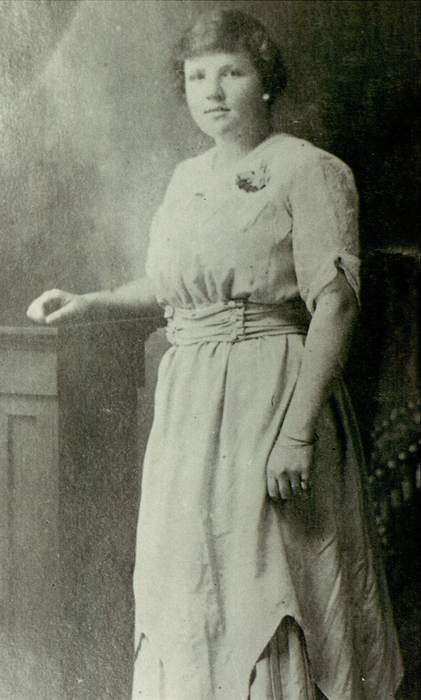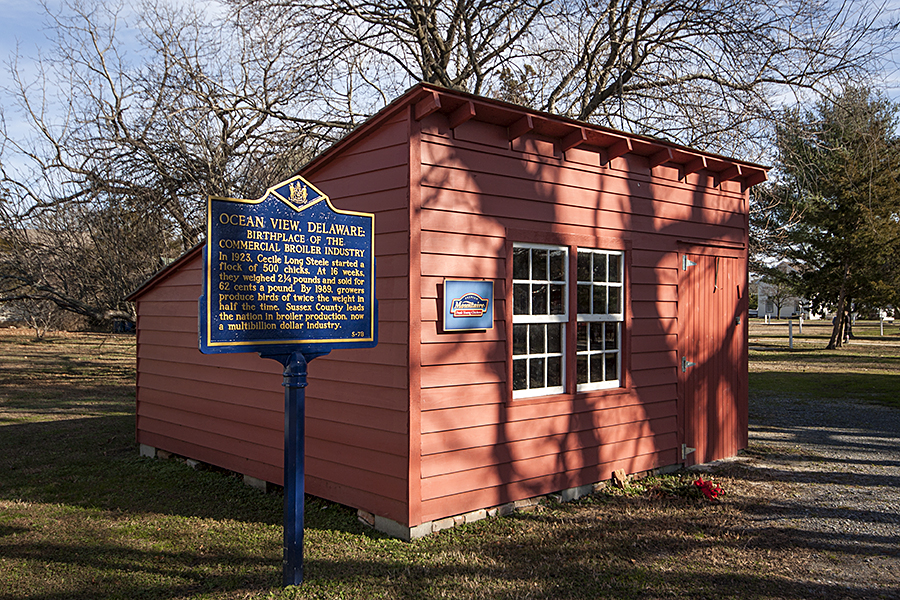The Back Story
Stewed, fried, baked, grilled, or broiled, skinless or boneless, in parts or whole, chicken is a big presence in the American diet. Statistics as of 2014 show that we consume 8 billion chickens per year in the U. S., or nearly 22 million a day. Americans consume chicken wings – once known by their purported place of origin as Buffalo wings – in vast quantities: 100 million pounds of wings are eaten in the U. S. on Superbowl weekend alone. The production of broiler chickens is a major industry, and one of the most important agricultural activities in Southern Delaware, a fact that no one who lives there can dispute. Long chicken houses are seen everywhere in rural Sussex and southern Kent Counties; three of the top twenty broiler processing companies in the U. S. – Allen Harim, Mountaire, and Townsend – are located in Sussex County, and Perdue is just across the state line in Salisbury, MD. Chickens outnumber humans in Delaware 200 to 1.
This was not always the case. Before 1923, chickens in Delaware and elsewhere were bred for egg production, not meat. They were barnyard livestock, free-ranging long before that term appeared on pricier chicken in supermarkets and restaurants. Egg production typically provided for the needs of individual families, or to barter at the general store; it was not a big cash business. As a result, chicken usually appeared at the dinner table only when non-productive birds were culled from the hen house, or when male chickens (cockerels) were killed in the springtime. However, a delivery mistake in Ocean View, Sussex County, DE, would have far-reaching economic and environmental ramifications for Sussex County and the DelMarVa.


Cecile Long Steele, a red-haired farm wife in Ocean View, ordered 50 chicks from Vernon Steen’s Dagsboro hatchery in 1923 for egg production; by mistake, Steen sent her 500 chicks, far too many for the intended purpose. Mrs. Steele did not return them, however; seeing an opportunity, she waited until the 387 surviving chickens reached 2 pounds live weight and sold them for a profit at 62 cents a pound. The following year, she raised 1,000 chicks and sold them for 50 cents a pound. In 1926, she raised and sold 10,000 broilers, and by 1928 she increased that number to 26,000. Success like this did not go unnoticed; by 1928 there were 500 growers raising broilers in Delmarva.
There were other important factors in the rapid rise in broiler chicken production in the 1920’s. Some of these were negative: commodity prices for American farmers, which were high during WWI, were depressed after European farms once again began producing at prewar levels; a fungus was decimating strawberry plants, a major source of income on the peninsula; changing salinity levels in the inland bays greatly reduced the numbers of fish and shellfish that farmers had previously been harvesting for additional income; and finally, egg-laying hens were dying in large numbers from disease once they had grown to the point at which they could lay eggs.
Other factors were favorable to chicken production: low labor costs, a relatively mild climate, plentiful cheap lumber for building chicken houses, close proximity to major seaports and huge urban markets in the mid-Atlantic and Northeast, and the willingness of local banks, hatcheries and feed companies to provide credit to growers. The ascendancy of large grocery store chains such as A&P, Krogers, Grand Union, and Acme, which were beginning to attract large numbers of customers, also added to the growing demand for poultry.
In addition to all of the above, chickens raised for meat had two big advantages over other domestic animals. First, hen houses needed relatively little space compared to hogs and especially cattle; second, chickens grew from chicks to market size (about 2 pounds) in weeks, while hogs needed months and cattle needed a year or more to reach market weight.
There was another byproduct of chicken production that proved to be a blessing as well as a curse. Chicken manure, produced in vast quantities by broilers, is very high in phosphates and nitrogen; that made it a highly effective fertilizer, increasing yields several hundred percent per acre in many instances. Over the years, however, it was discovered that plants did not absorb all the phosphates in the fertilizer; the excess was carried by runoff into the Chesapeake Bay and its estuaries, creating huge algae blooms that consumed all the oxygen in their midst and made it impossible for any other living thing to survive there. Environmental scientists are still grappling with this problem today.
Today, there are 2,700 chicken houses in Sussex County producing 200 million broilers annually. Hybrid broilers reach a market weight of 4 pounds in seven to eight weeks, instead of the 2 pound weight at 18 weeks in 1923.

There is a bittersweet epilogue to Cecile Steele’s story. She and her husband David Wilmer Steele, a Delaware State Senator, enjoyed real financial success in the 1930’s. They bought a substantial home in Ocean View, now the Cafe on 26, as well as a $10,000 yacht, the Lure. On October 7, 1940, the Steeles, their guests John A. Tubbs from Selbyville and Mrs. Elliott Evans, and yacht captain William Murray went fishing off of Ocean City, MD. After about an hour and a half on the water, they decided to return to port. David Steele placed his foot on the starter pedal to restart the yacht’s engine, and an explosion occurred that threw everyone into the water. A second explosion, probably the fuel tanks, enveloped the boat in flames. Both Steeles died from heart failure according to the coroner’s inquest, while the 23-year-old captain and two guests survived, although they all sustained burns. Incredible as it may seem, not one word was written about Cecile Steele’s impact on the poultry industry in any newspaper report of the explosion or the funeral that followed; her politician husband got all of the press attention. There is an anecdote that was communicated to me by the Ocean View Historical Society that the bodies of the Steeles lay “in state” in the parlor of their home prior to the funeral, and elementary schoolchildren were brought by their teacher to pay their last respects. There is no independent corroboration of this story in any newspaper of the day.
More than four decades later, on October 25, 1983, Cecile Steele was inducted into the Delaware Hall of Fame for Women for her part in the start of one of Delaware’s most important economic activities. A historic marker placed by the Delaware Public Archives can be found in the village of Ocean View, DE in front of an exact replica of Cecile Steele’s first chicken house. The latter was constructed by the Ocean View Historical Society in John West Park; next to it is the old Post Office of Ocean View. A plaque from the Mountaire Poultry Processing Company is mounted on the front of the chicken house; I would guess the company funded the construction of the replica in whole or in part. There is a story told in Ocean View that Cecile put her first 500 chicks in a piano box until her husband built her a proper chicken house. This may be apocryphal.

In my next post, I will write about John Sudler Isaacs and his foray into chicken production in 1939, sixteen years after Cecile Steele began it all.
————————————
Sources
Williams, William H. Delmarva’s Chicken Industry – 75 Years of Progress. Delmarva Poultry Industry. 1998
Kee Jr., W. Edwin. John Sudler Isaacs – A Sussex County Visionary. Delaware Heritage Press, 2009
Senator D. W. Steele, Wife Die In Blast On Boat. Wilmington Morning News. October 8, 1940
Throng Attends Steele Funeral. Wilmington Morning News. October 11, 1940
Cohen, Ed. The Mother Hen to Today’s Broiler. Wilmington Morning News. July 14, 1985

I learned about this in school today. We are showing our students a video that gives a nod to Delaware as the orgin of chicken production.
Mr. Martin, thank you for your interest in the Milton History blog I write. Cecile Steele’s story is somewhat tangential to Milton’s economy, but a piece I did about John Sudler Isaacs, a local chicken producer and big land owner a couple of generations ago, required that I look at the history of the poultry industry in Delaware. The video you showed, would that happen to be “Cluck, Pluck and Luck”? I found it very informative when I was doing the Cecile Steele story. By the way, what school are you principal of?
This article really fills in some family history gaps. Thanks for the research, Cecile was daughter-in-law of my great uncle.
Thank you for your interest in this post. I always appreciate comments, but even more so from family members!
My oldest son Michael David Steele (Saranac, MI) was watching a documentary about food production in America a few nights ago. He texted me and asked: is Cecile Steele your Great Grandmother, there was a story about her on the the program and I remember my Pop Pop telling me a story about Cecile and her contribution to poultry production”. His text sent me scurrying around looking for information. I called my two brothers, Richard Elliot (his response to this blog noted Dec. 28) and Robert Carl . Rob had some articles passed on from my Dad and Dick had a family ancestry chart as well. We then found this Blog and now we have a much better understanding of Cecile Steele’s significant contribution to the poultry business in the southern Delaware and Maryland region! This is a Great story to share with my three Grand-daughters all teenagers!
Again, Cecile was daughter-in-law of my Great Uncle
Cecile Steele’s impact on southern Delaware cannot be overstated. We’re known for three things in LSD (lower slower Delaware): beaches, chickens, and Joe Biden’s summer home in Rehoboth Beach. Of the three, chicken production has brought about the greatest changes in agriculture and ancillary industries. For example, where you once could see a lot of diversity in the types of food grown here, the major portion of farm acreage (that hasn’t been sold off to home builders) is soybeans and corn: chicken feed. Cecile’s chickens used to be what we now call “free range,” but now you almost never see a chicken outside unless a poultry truck has overturned, which happened right at the entrance to my community in Milton. Everything is industrial scale now – the big packers like Perdue and Mountaire provide food and chicks to farmers, and contract with the farmers to raise them to market weight.
Mr Martin,
I thoroughly enjoyed your article about Cecile Steele and how she started the huge chicken industry of today! I cannot remember how I came across her name and or her relationship to todays chicken industry, but am certainly glad I saved the link that I found by by googling her name. I will google “John Sudler Isaacs and his foray into chicken production in 1939” and see if I can find your article about him — hopefully it will turn up!
Mr. Warren, thank you so much for your interest in this blog post! Here is the link to the Isaacs story you mentioned, if you haven’t found it already: https://broadkillblogger.org/2017/01/jsi-partiii/
this amazing woman have the courage and challegend the world with the modern production and introduction of the chicken offering it to the modern food…!!!
Sorry to take so long to respond; I have not been active on the blog for a few months because of real-world work issues. I appreciate your interest – thank you!
Interesting.